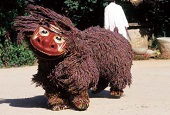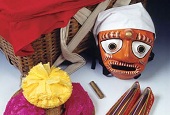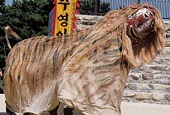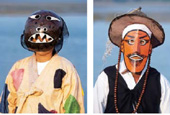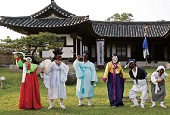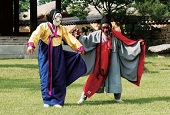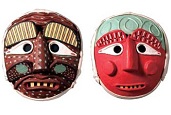View this article in another language
- 한국어
- English
- 日本語
- 中文
- العربية
- Español
- Français
- Deutsch
- Pусский
- Tiếng Việt
- Indonesian
This is the eighth part in our series, “Masks & the Mask Dance” published in partnership with the National Research Institute of Cultural Heritage
Kkun: The artisans who embrace masks and mask dances as part of their lives.
The making of Korean masks
Depending on the type of material used, Korean masks can be divided into four categories: wood, paper, gourds and bamboo.
The masks of the Hahoe exorcism mask dance are made of wood. Those of the Haeseo mask dance are made of paper, while the ogwangdae and yaryu dance styles use masks made mainly from gourds. In addition, bamboo is used with some masks, including the lion mask of Bongsan mask dance, the lion and tiger masks of the Suyeong yaryu, and the leper, servant and lion masks of Tongyeong ogwangdae. Some masks were made originally of wood but were later constructed from paper or gourds.
Here is the process of making masks by using gourds, paper, wood or bamboo.
Gourd masks

01 Draw an outline of the face with a pencil and use a knife to carve it out.
02 Separately, form a nose and attach it to the face. Glue pieces of traditional mulberry paper over the nose.
03 Glue pieces of traditional mulberry paper over the gourd.
04 Drill holes for the eyes and mouth.
05 Paint the mask in the character's representative colors.
06 Paint the mask in the colors most commonly associated with that character.
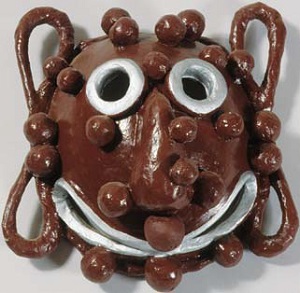
Paper masks

01 Mold the clay into the shape of a face and pour on the plaster.
02 When the plaster hardens, dig out the clay and apply soapy water to the inside of the plaster mold and glue in pieces of traditional mulberry paper.
03 When the glued traditional mulberry paper is dried, remove it from the plaster mold.
04 Paint the mask to suit the character.
05 Attach a strap and a piece of cloth to the top of the finished mask.
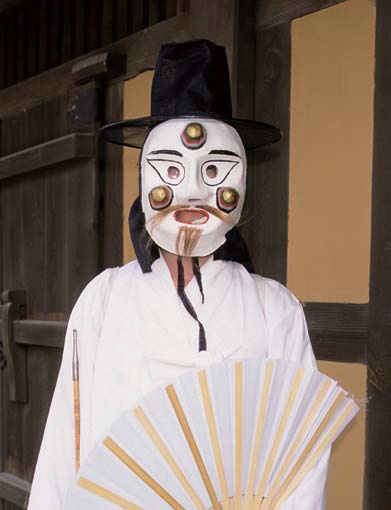
Wooden masks

01 Use a saw and a chisel to cut out a properly sized piece of wood.
02 Chisel out the back of the wood, creating the hollow of the mask's back.
03 Chisel out the face on the front of the mask.
04 Carve out the details of the face.
05 Glue pieces of traditional mulberry paper over the mask.
06 Paint the mask in the appropriate colors.
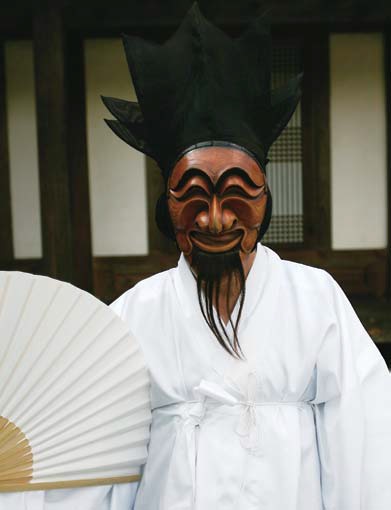
Bamboo masks

01 Prepare a large bamboo basket.
02 Twist together some thin strips of paper to make a type of string.
03 Glue the paper string onto the basket to make a face: eyes, wrinkles and lips.
04 Apply a thin layer of white clay over the surface of the mask.
05 Dry the mask in the sun.
06 Paint the mask orange.
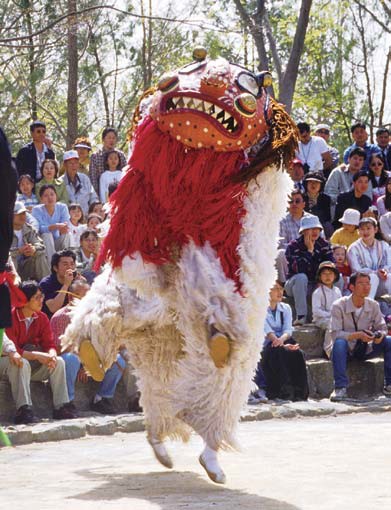
* This series of article has been made possible through the cooperation of the National Research Institute of Cultural Heritage. (Source: Intangible Cultural Heritage of Korea)
Kkun: The artisans who embrace masks and mask dances as part of their lives.
The making of Korean masks
Depending on the type of material used, Korean masks can be divided into four categories: wood, paper, gourds and bamboo.
The masks of the Hahoe exorcism mask dance are made of wood. Those of the Haeseo mask dance are made of paper, while the ogwangdae and yaryu dance styles use masks made mainly from gourds. In addition, bamboo is used with some masks, including the lion mask of Bongsan mask dance, the lion and tiger masks of the Suyeong yaryu, and the leper, servant and lion masks of Tongyeong ogwangdae. Some masks were made originally of wood but were later constructed from paper or gourds.
Here is the process of making masks by using gourds, paper, wood or bamboo.
Gourd masks

01 Draw an outline of the face with a pencil and use a knife to carve it out.
02 Separately, form a nose and attach it to the face. Glue pieces of traditional mulberry paper over the nose.
03 Glue pieces of traditional mulberry paper over the gourd.
04 Drill holes for the eyes and mouth.
05 Paint the mask in the character's representative colors.
06 Paint the mask in the colors most commonly associated with that character.

The maduggi mask from the yaryu dance style from Suyeong.
Paper masks

01 Mold the clay into the shape of a face and pour on the plaster.
02 When the plaster hardens, dig out the clay and apply soapy water to the inside of the plaster mold and glue in pieces of traditional mulberry paper.
03 When the glued traditional mulberry paper is dried, remove it from the plaster mold.
04 Paint the mask to suit the character.
05 Attach a strap and a piece of cloth to the top of the finished mask.

The yeonggam mask is used in mask dances from Eunyul.
Wooden masks

01 Use a saw and a chisel to cut out a properly sized piece of wood.
02 Chisel out the back of the wood, creating the hollow of the mask's back.
03 Chisel out the face on the front of the mask.
04 Carve out the details of the face.
05 Glue pieces of traditional mulberry paper over the mask.
06 Paint the mask in the appropriate colors.

The nobleman's mask from the Hahoe mask dance.
Bamboo masks

01 Prepare a large bamboo basket.
02 Twist together some thin strips of paper to make a type of string.
03 Glue the paper string onto the basket to make a face: eyes, wrinkles and lips.
04 Apply a thin layer of white clay over the surface of the mask.
05 Dry the mask in the sun.
06 Paint the mask orange.

The lion mask from the Gangnyeong mask dance.
* This series of article has been made possible through the cooperation of the National Research Institute of Cultural Heritage. (Source: Intangible Cultural Heritage of Korea)
Most popular
- 'We are back!' BTS Festa heralds hyped return of K-pop phenom
- K-pop streaming on Spotify skyrockets 470-fold in 10 years
- Hallyu gala MyK Festa from June 19 to feature K-pop acts
- President Lee starts G7 schedule via talks with S. Africa, Australia
- Korea Beauty Festival offers 'journey to find one's own beauty'

